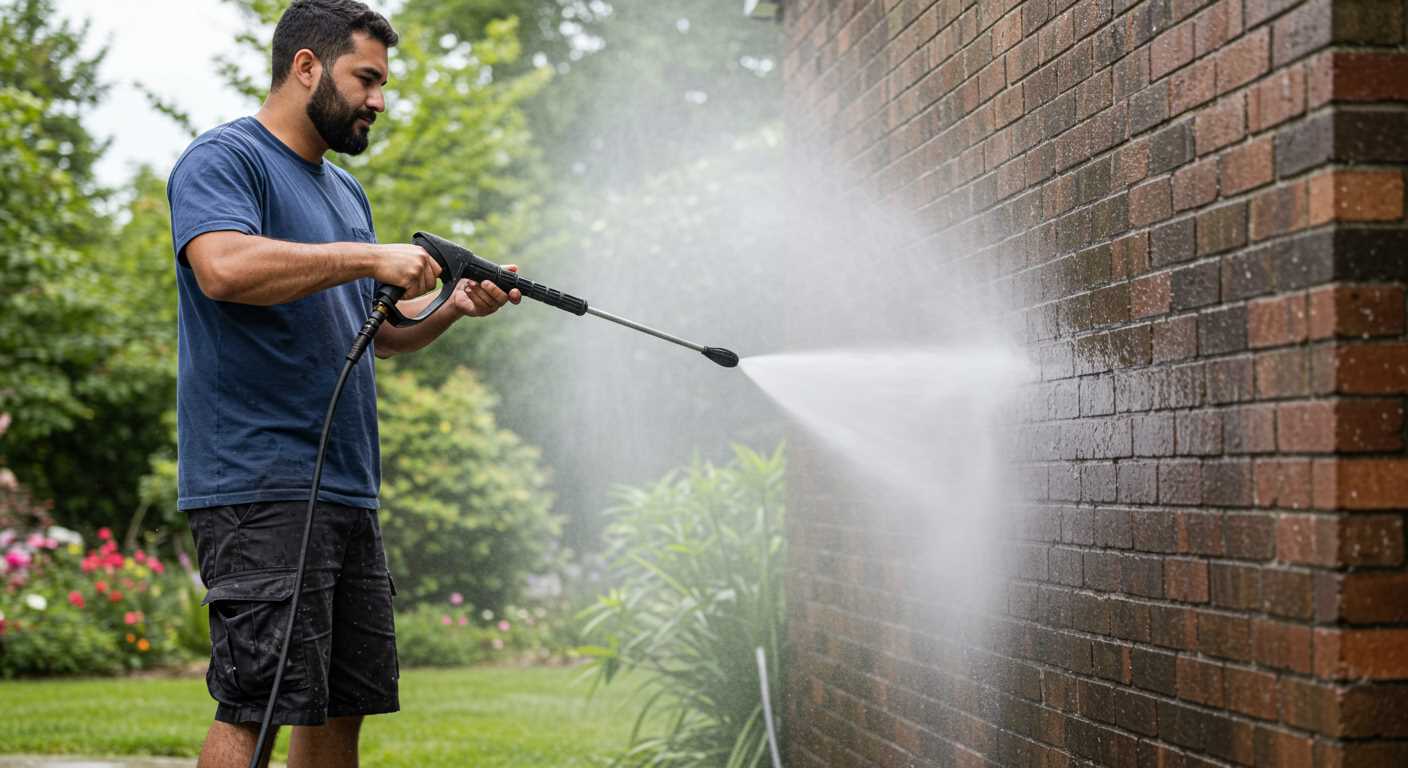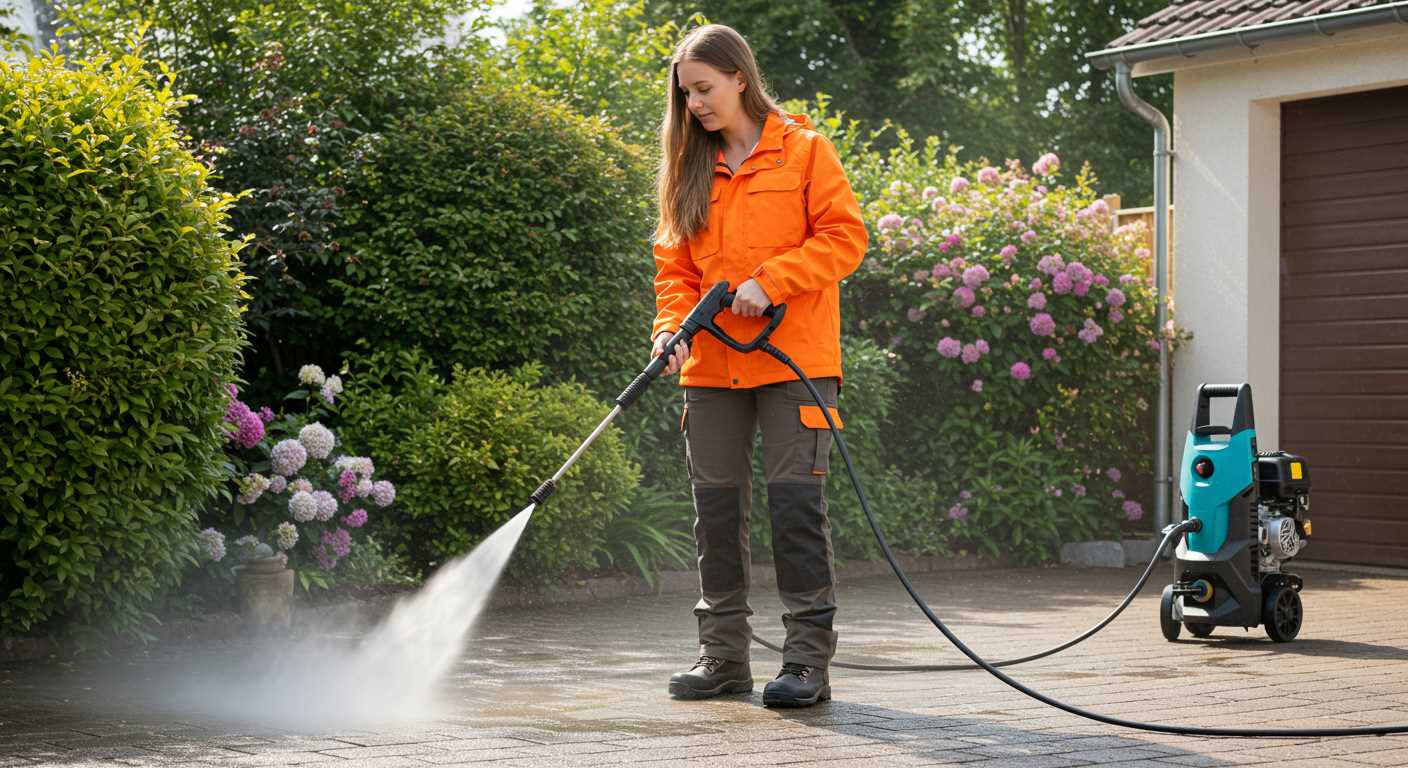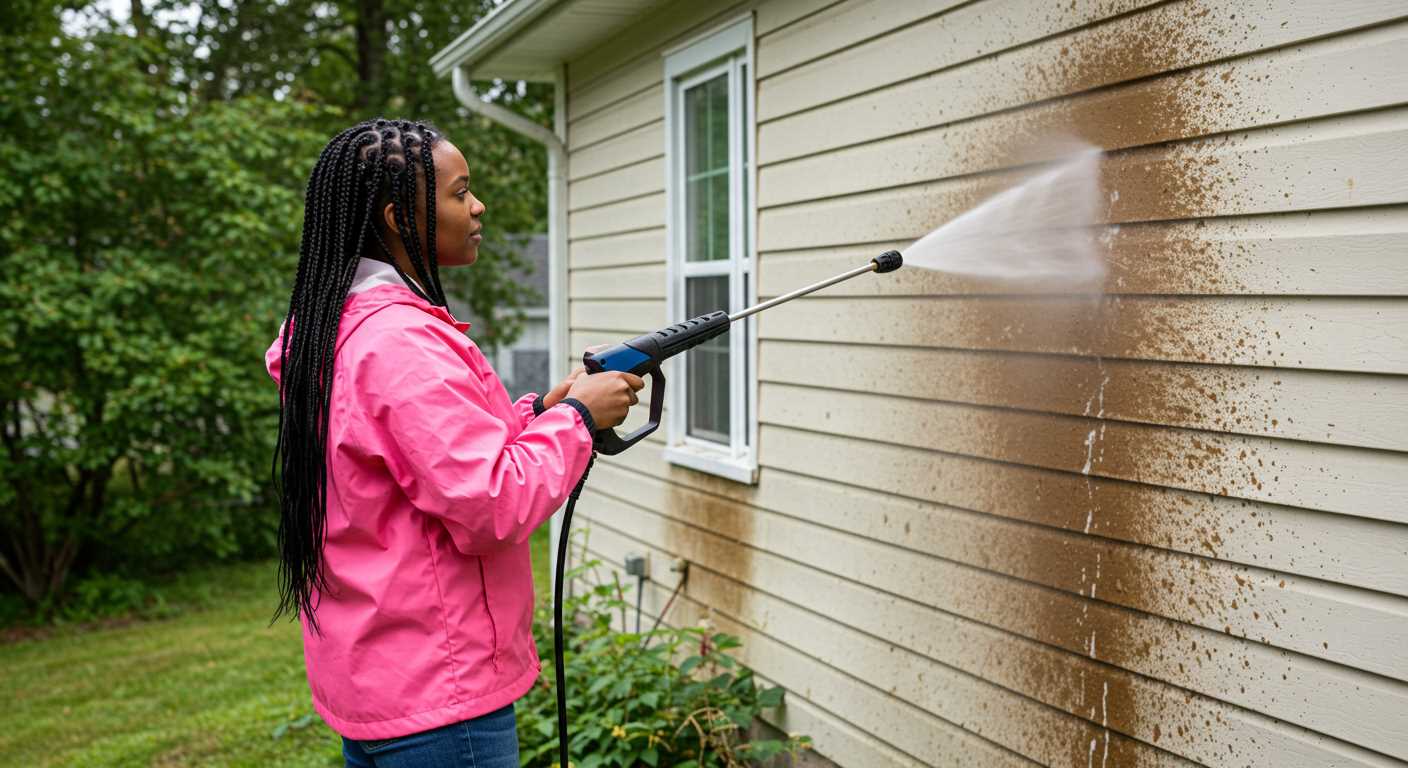



.jpg)
Start by selecting the right nozzle for the task; a 25-degree or 40-degree one works best for most surfaces, providing a balance of power and precision. Adjusting the nozzle distance is crucial; maintain a distance of about 12 inches from the surface to avoid damage. Always test a small, inconspicuous area first to ensure compatibility with the material.
Prior to operation, clear the area of furniture, plant pots, and debris. This not only enhances safety but also ensures an unobstructed cleaning path. For stubborn stains, pre-treating with a suitable cleaner can yield remarkable results. Allow the solution to sit for the recommended time before rinsing; this ensures that the grime loosens effectively.
During the process, maintain a consistent sweeping motion. This reduces the likelihood of streaks and ensures uniformity in cleanliness. Overlapping each pass slightly will cover all areas thoroughly. Pay special attention to the joints, where dirt tends to accumulate. A focused approach with the nozzle can dislodge even the most entrenched debris.
After completing the task, rinse the area with fresh water to remove any lingering cleaning agents. This step is vital for preventing slippery surfaces. Finally, allow everything to dry completely before replacing any items back in their original spots. This simple routine can dramatically enhance the look and longevity of your hard surfaces.
Choosing the Right Pressure Washer for Paving Slabs
For tackling stubborn grime on outdoor surfaces, selecting the appropriate machine is paramount. A few key factors determine the best choice for optimal results.
- Pressure Rating: Look for a unit delivering at least 130 bar (1900 psi). This level effectively removes dirt and moss without damaging the surface.
- Flow Rate: Aim for a minimum of 450 litres per hour. Higher flow rates ensure thorough rinsing, reducing the need for multiple passes.
- Cleaning Attachments: A rotating nozzle or surface cleaner can enhance efficiency. These attachments distribute water evenly, preventing streaks and missed spots.
- Portability: A lightweight model with wheels simplifies movement around the area. Consider the hose length as well; a longer hose allows for greater reach without repositioning.
- Motor Type: Electric models are quieter and suitable for smaller tasks. Petrol machines provide more power and are ideal for larger areas or more demanding jobs.
During my years in the cleaning equipment industry, I’ve seen many users struggle with underpowered machines. One memorable instance involved a customer attempting to revive a neglected patio. Despite enthusiasm, their low-pressure device barely made an impact. Once they upgraded to a higher-rated model, the transformation was impressive.
Maintenance is another consideration. Regularly check and replace nozzles as worn ones can reduce efficiency. Additionally, ensure the water source is clean to avoid clogs.
Lastly, always read the manufacturer’s guidelines. Each model has specific recommendations for use, and adhering to these can prolong the life of the equipment.
Preparing the Area Before Cleaning
Begin by clearing the designated zone. Remove any furniture, planters, or decorative elements. This not only protects them but also ensures unobstructed access for thorough scrubbing. I once overlooked this step and ended up with a soaked garden bench that took hours to dry out.
Next, inspect for debris such as leaves, twigs, or stones. These can become airborne projectiles during operation, potentially causing damage or injury. After a windy day, I found a rogue pebble that shattered a nearby window when hit. A quick sweep or vacuum can save a lot of hassle.
Consider any nearby plants. Covering them with tarps or plastic sheeting is wise to prevent any unwanted water or cleaning solution exposure. I had a friend who lost a prized rose bush because he neglected this precaution. It’s easier to take a few moments for protection than to replace cherished flora.
Check for any cracks or loose stones in the surface. Addressing these prior to starting can prevent further damage during cleaning. I’ve seen surfaces get worse when pressure is applied to weak spots. A little maintenance beforehand can make a substantial difference.
If a cleaning solution is planned, ensure it’s appropriate for the specific material. Read labels carefully and test a small area first. In my experience, using the wrong product can lead to discolouration or damage. Always better to be safe than sorry.
Lastly, assess the weather conditions. Avoid working on windy or rainy days, as these can impact effectiveness and safety. I’ve been caught in unexpected downpours, which turned a simple task into a slippery mess. Choose a clear day for the best results.
Setting Up Your Pressure Washer Correctly
Before starting, ensure the device is assembled correctly according to the manufacturer’s instructions. A well-assembled unit performs better and is safer to operate.
Check Water Supply and Connections
- Ensure a stable water supply; a garden hose connected directly to a tap works best.
- Inspect all connections for leaks. Tighten any loose fittings to prevent water loss.
- Use a hose with a diameter of at least 1/2 inch for optimal flow.
Selecting the Right Nozzle
Different tasks require different nozzles. For tougher grime, a narrower nozzle (like 0° or 15°) provides concentrated power. For general cleaning, a 25° or 40° nozzle is more suitable. Consider using a best car wash pressure washer nozzle foam cannon gun sprayer for foam application, which can pre-treat surfaces effectively.
Adjust the nozzle according to the surface type. Start from a distance of at least 2 feet, gradually moving closer as needed to avoid damage to the material.
Always test a small area before proceeding with the entire surface. This approach helps identify the right pressure and technique for the specific job.
Selecting the Appropriate Nozzle for Paving Slabs
For optimal results, a 25-degree nozzle is your best bet. This fan-style attachment strikes a balance between power and coverage, allowing for effective removal of dirt and grime without risking damage to your surfaces. I’ve often found that using a more concentrated nozzle, like a 15-degree, can be tempting for stubborn stains, but this may lead to etching or chipping the stone.
When dealing with delicate surfaces, consider employing a soap nozzle if your equipment supports detergent use. It helps to apply cleaning solutions evenly, enhancing the cleaning process. I recall a particularly stubborn stain on a patio, where I used a soap nozzle to pre-treat the area before switching back to the 25-degree for the final rinse. The results were impressive.
Always test your chosen nozzle on a small, inconspicuous area first. This practice can prevent any unforeseen damage and ensure that the cleaning pressure is suitable. In my experience, many individuals overlook this simple step, leading to costly repairs.
Lastly, if you encounter any issues during setup or operation, refer to pressure washer repair and troubleshooting solutions to common problems. This resource can provide valuable insights and save time, allowing for a smoother cleaning process.
Adjusting Pressure Settings for Optimal Cleaning
Begin by setting the pressure to a moderate level, typically around 1500 to 2000 PSI. This range effectively removes grime without damaging surfaces. I recall a time when I used too high a setting on a delicate stone surface, resulting in etching that required professional repair.
After starting at a moderate pressure, observe the results. If stubborn stains remain, gradually increase the pressure in increments of 100 PSI. This method allows for a careful assessment of the surface’s response to increased force. Each surface reacts differently; some may require a firmer touch while others could be damaged easily.
Always position the nozzle at a 45-degree angle to the surface. This technique helps direct water flow effectively while minimising the risk of harm to the material. I’ve found that maintaining this angle not only enhances cleaning efficiency but also protects the edges from chipping.
For particularly tough areas, a higher pressure can be beneficial, but ensure to test a small, inconspicuous section first. During a recent project, I discovered that a slight increase in pressure removed embedded dirt effectively, but only after validating it on a less visible area to avoid mishaps.
Monitor the surface closely as adjustments are made. If you notice any signs of damage or wear, reduce the pressure immediately. Remember, achieving a clean look isn’t solely about power; it’s about finding the right balance. Over the years, I’ve learned that patience and precision yield the best results.
Techniques for Cleaning Different Types of Stains
For oil stains, a degreaser applied before using a high-pressure cleaner is effective. Let it sit for about 15 minutes to penetrate the oil. Follow up with a powerful nozzle to lift the residue out of the surface. Consider using a hot water option if available; it enhances cleaning efficiency significantly.
Rust Remnants
Rust can be particularly stubborn. An acidic cleaner specifically designed for rust can be applied to the affected areas. Allow it to soak for about 10 to 20 minutes. After that, use a wide-angle nozzle to blast away the loosened rust. If the rust persists, repeating the application may be necessary.
Moss and Algae

Moss and algae require a different approach. A mixture of water and bleach can be effective in killing these growths. Apply it generously and allow it to sit for about half an hour. Afterward, a more concentrated spray can be used to remove the dead moss and algae, ensuring to use a fan tip for better coverage.
| Stain Type | Recommended Treatment | Application Time</th |
|---|---|---|
| Oil | Degreaser followed by high-pressure washing | 15 minutes |
| Rust | Acidic cleaner followed by high-pressure washing | 10-20 minutes |
| Moss/Algae | Bleach solution followed by high-pressure washing | 30 minutes |
Adjustments to techniques may be necessary based on specific conditions, such as the age of the surface or the severity of the stains. Always test any cleaner on a small, inconspicuous area first to avoid damage.
Post-Cleaning Care for Paving Slabs
After tackling the grime and dirt, it’s crucial to give some attention to the surface. Start by rinsing the area with clean water to remove any leftover detergent or debris. This simple step helps to prevent residue build-up, ensuring that the surface remains pristine.
Sealing the Surface
Applying a sealant can significantly extend the life of the surface. I recommend choosing a breathable sealant that allows moisture to escape while preventing stains and dirt from penetrating. I’ve found that this can make maintenance much easier in the long run. Wait at least 24 hours after cleaning before applying the sealant to ensure the surface is completely dry.
Regular Maintenance Schedule
Set a routine for upkeep. A quick wash every few months can keep the surface looking fresh. During the growing season, be vigilant about removing any weeds or moss that may appear. I’ve seen how a simple monthly sweep can prevent larger issues down the line. Additionally, consider using a mild cleaner during regular maintenance to preserve the look and integrity of the material.
Investing a bit of time in post-cleaning care pays off, making future clean-ups simpler and maintaining the appeal of your outdoor space.
Safety Precautions While Using a Pressure Washer
Always wear appropriate personal protective equipment. A good pair of safety goggles shields eyes from debris and water spray. Sturdy, non-slip footwear prevents slips on wet surfaces, while gloves protect hands from high-pressure water and cleaning agents.
Maintain a safe distance from the surface being treated. Keeping the nozzle at least 30 cm away helps prevent damage to the material and reduces recoil. A firm grip on the wand is crucial to control the equipment effectively.
Check for any electrical hazards before starting. Ensure that all electrical connections are secure and protected from water. Using an RCD (Residual Current Device) can prevent electrical shocks.
Inspect hoses and connections thoroughly. Look for cracks or leaks that may pose risks during operation. Replace any damaged components immediately to avoid accidents.
Be mindful of surroundings. Ensure no people, pets, or fragile items are within the spray zone. This not only protects them but also prevents unintentional damage to property.
Test pressure settings on a small, inconspicuous area first. Observing how the surface reacts will help determine the appropriate setting for the task at hand.
Keep the nozzle pointed downwards and away from body parts at all times. Accidental discharge can cause serious injuries. Always release the trigger when adjusting the spray pattern or changing nozzles.
Take breaks to avoid fatigue. Operating equipment for extended periods can lead to lapses in attention, increasing the risk of accidents. Regular intervals provide an opportunity to reassess safety and equipment performance.
Lastly, never operate the machine in inclement weather. Rain or strong winds can affect control and increase hazards. Wait for clear conditions to ensure a safe cleaning experience.

.jpg)




.jpg)


